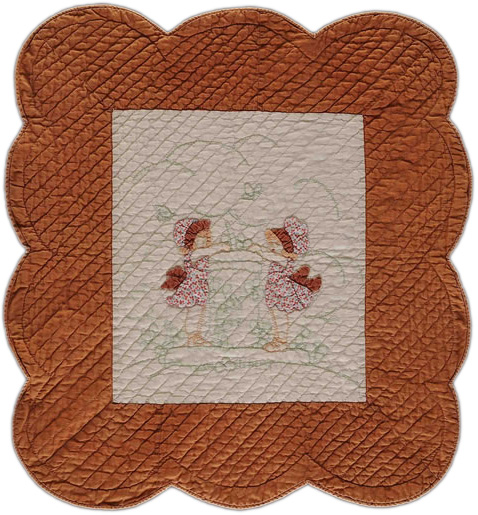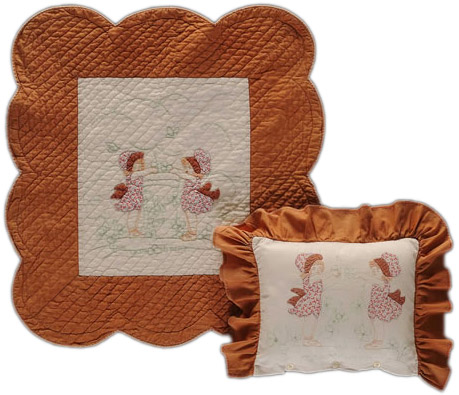
QUILT INDEX RECORD
18-14-64
Description:
This 1940s Doll Quilt was made for grand-daughter Susan Krueger. It has a matching pillowcase. Gasperik's pattern source might have been an illustration for the nursery rhyme "London Bridge Is Falling Down", although the needlework pattern or quilt kit source has not been identified. See also #054 What Are Little Girls Made Of? another doll quilt made by Gasperik.
Where are the records for this quilt housed?
Mary Gasperik Legacy Project
Who documented this quilt?
Mary Gasperik Private Collection
Gasperik Legacy Project Number:
038
This is a:
Finished quilt
Quilt's title:
Doll Quilt
Owner's name for quilt:
Doll Quilt
How wide is the quilt?
21 inches
How long is the quilt?
22 inches
Shape of edge:
Scalloped
Shape of corners:
Scalloped
What color is the quilt?
Rust; White
Quilt's condition:
Good/moderate use
Time period:
1930-1949
When was the quilt finished?
1945
Family/owner's date for quilt:
1945
Date estimated by an antique dealer, quilt historian or appraiser:
1940s
Who estimated the quilt's date?
Merikay Waldvogel
Further information concerning dates:
Made for grand-daughter born in 1940
Describe the quilt's layout:
Medallion or framed center
Describe the borders:
One wide border scalloped on the outer edge.
Fiber types used to make the quilt top:
Cotton
Fabric styles used in the quilt top:
Print; Solid/plain
Applique techniques used to make the quilt top:
Hand Applique
Embellishment techniques used to make the quilt top:
Embroidery
Materials used to make the back:
Cotton
What color is the back of the quilt?
White
Number of pieces of fabric in the quilt back:
1
Describe the back:
Solid/plain
Materials used in the quilt binding:
Cotton
Fabric structure of the binding:
Plain weave
How is the binding made?
Bias grain
What is the width of the binding (measure on the top only)?
less than a half inch
What kind of filling is used in the quilt?
Cotton
How are the layers held together?
Hand quilting
Color of thread used in the quilting:
white
Number of quilting stitches per inch, place 1:
10
Number of quilting stitches per inch, place 2:
11
Width between quilting lines:
.5"
Can you see any knots on the front or back of the quilt?
no
Quilting designs used, overall motifs:
All-over-design; Patches outlined/in the ditch; Single parallel lines
Quilting designs used, background fills:
Parallel lines
Quilt top made by:
Gasperik, Mary
Quilted by:
Gasperik, Mary
Where the quilt was made, city:
Chicago
Where the quilt was made, county:
Cook County
Where the quilt was made, state:
Illinois (IL)
Where the quilt was made, country:
United States
How was this quilt acquired?
Gift
Tell the story of how the quilt was obtained:
I remember using this quilt a lot in my doll buggy. It was probably given to me when I was about 5 (ie 1945).
Describe anything about the history of the quilt that wasn't already recorded in a previous field:
Dolls, and doll buggies, and playing with dolls - these were very important in our 3-sisters household.
Why was the quilt made?
Gift or presentation
The quilt was made to be used for:
Doll quilt/toy
Quilt is presently used as:
Keepsake/memento
Describe present uses of the quilt:
Mary's grandchildren regard her quilts as a unique collection to be preserved and appreciated.
Where did the maker get their materials?
Purchased new
Where did the maker find their pattern?
Unknown
Commercial name of the pattern for the top:
Source of applique figures not found.
Describe anything about the design of the quilt that wasn't already recorded in a previous field:
This doll quilt has a matching pillowcase, which may indicate it was a doll quilt kit or pattern rather than a quilt block design. One has to wonder , if this was a commercial pattern or kit, if it might have been named "London Bridge", as in the nursery rhyme song. It looks like these two girls are playing London Bridge.
Publications (including web sites) where this quilt or maker was featured:
Merikay Waldvogel and Barbara Brackman. Patchwork Souvenirs of the 1933 Chicago World's Fair, (Nashville, TN: Rutledge Hill Press, 1993)102-103.
Merikay Waldvogel "One American Dream Comes True", Quilters Newsletter Magazine, March 2008, 46-49.
Ownership of this quilt is:
Private
Quilt owner's name:
Susan Krueger Salser
Quilt owner's country:
United States
Person filling out this form is:
Relative of quiltmaker; Quilt owner; Author/researcher
If you are a relative of the quiltmaker, how are you related? The quiltmaker is my:
Grandmother
Describe the relationship to the quilt's maker:
Grand-daughter Susan Salser began this research effort in 1991, after she and her two sisters divided up the quilts which belonged to their mother (Elsie Gasperik Krueger) who died in 1988. Her ongoing research has been fruitful and interesting.
Quiltmaker's maiden name:
Mihalovits, Maria
Quiltmaker's gender:
Female
Quiltmaker's birth date:
01/25/1888
Quiltmaker's birthplace, country:
Hungary
Quiltmaker's marriage date(s):
11/18/1906
Quiltmaker's date of death:
05/25/1969
Quiltmaker's ethnic background/tribal affiliation:
Hungarian
Quiltmaker's educational background:
Elementary School
In which kind of environment did the quiltmaker live?
Rural
Quiltmaker's city:
Chicago
Quiltmaker's county:
Cook
Quiltmaker's state:
Illinois (IL)
Quiltmaker's country:
United States
Quiltmaker's father's name:
Mihalovits, Istvan
Quiltmaker's father's birthplace:
Hungary
Quiltmaker's father's ethnic/tribal background:
Hungarian
Quiltmaker's mother's name:
Mihalovits, Vidoszava
Quiltmaker's mother's birthplace:
Hungary
Quiltmaker's mother's ethnic/tribal background:
Hungarian
Quiltmaker's spouse's/spouses' and /or partner's/partners' name(s):
Gasperik, Stephen
Quiltmaker's spouse's/spouses' and/or partner's/partners' ethnic/tribal background:
Hungarian
Quiltmaker's spouse's/spouses' and/or partner's/partners' occupation:
Milk Dealer/Grocery Store Owner/Butcher
Number of children:
3
How many of the quiltmaker's children were girls?
1 (Elsie 1909-1988)
How many of the quiltmaker's children were boys?
2 (Elmer and Stephen)
How did the quiltmaker learn to quilt?
From guild or club member; Self-Taught
When did the quiltmaker learn to quilt?
Age 40-49
Why does the quiltmaker quilt?
Pleasure; Other
Other notes on how the quiltmaker learned, and how and why they quilt:
Mary Gasperik made quilts because it was her life passion and greatest talent. As opportunities arose, she entered contests and exhibited them publicly. She also made special quilts for her family.
Does/did the quiltmaker belong to a group? Name of the group?
Tuley Park Quilt Club and Detroit News Quilt Club
Does/did the quiltmaker belong to a group?
Southside Chicago and Detroit MI
What are the main activities of the group?
Chicago group met to quilt and held periodic quilt shows; Detroit group held national exhibits and contests.
Estimated number of quilts made by this quiltmaker:
more than 50
Does/did the quiltmaker sell quilts?
no
Does/did the quiltmaker teach quilting?
no
Who photographed this quilt?
Bruce Morr
Access and copyright information:
Restricted
Copyright holder:
Susan Salser
Details
Cite this Quilt
Gasperik, Mar. Doll Quilt. 1945. From Mary Gasperik Legacy Project, Mary Gasperik Private Collection. Published in The Quilt Index, https://quiltindex.org/view/?type=fullrec&kid=18-14-64. Accessed: 04/26/24
-
Gallery
Gasperik 05: Gifts for Children
Waldvogel, Merikay
-
Gasperik, Mary Quiltmaker
Mary Gasperik Legacy Project
